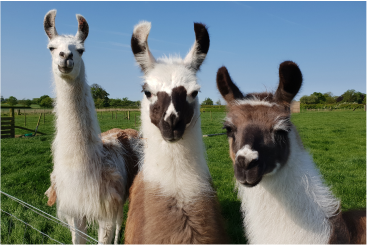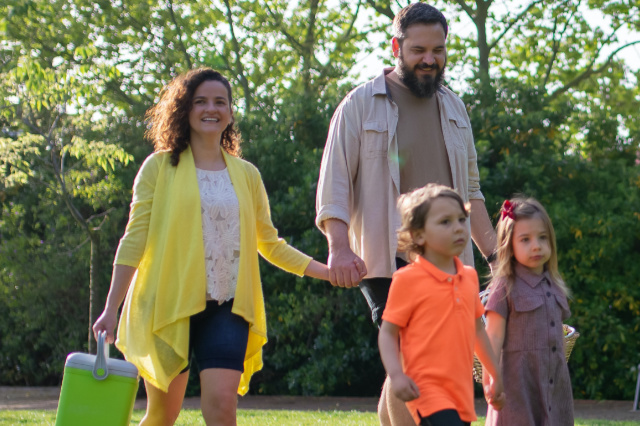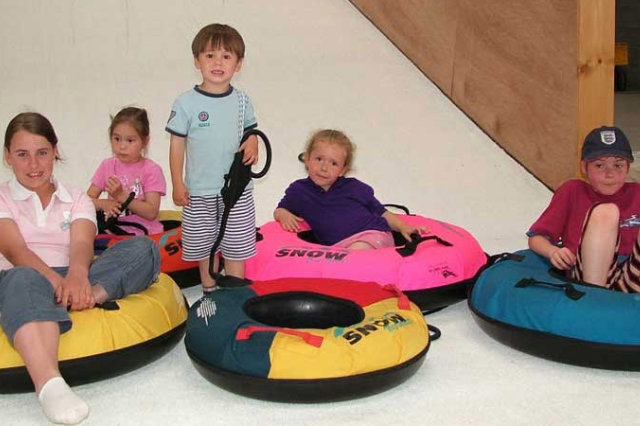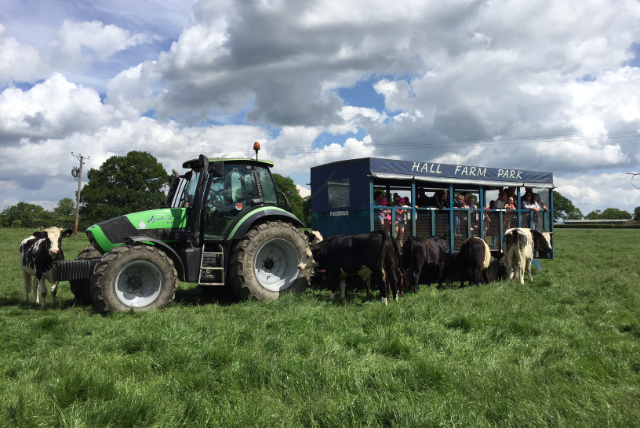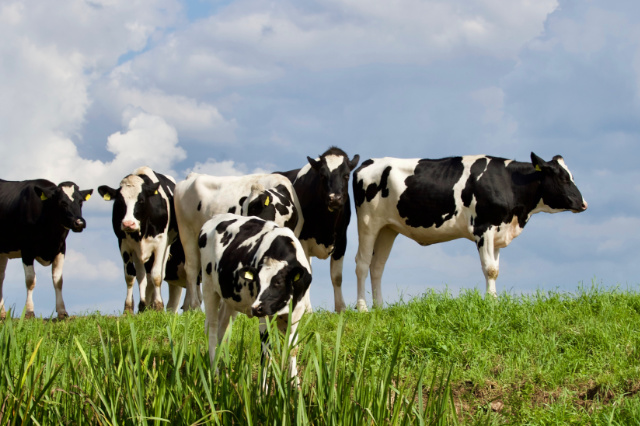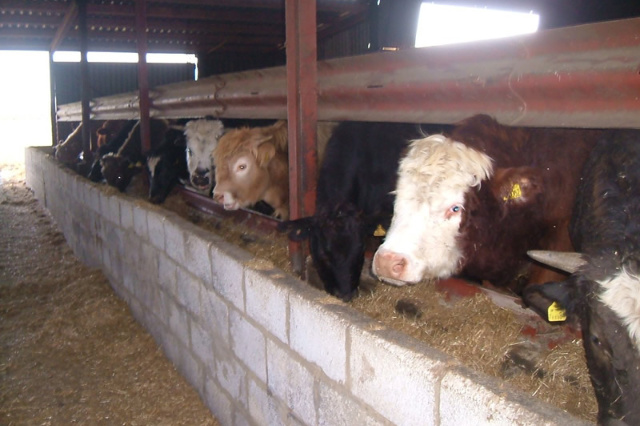
Winter
During the winter months, the cattle are brought from the fields and housed indoors, the cattle usually come inside in November and will remain inside until spring.
After the cattle have been in a few weeks we will take them into the holding area to give them a dose of wormer each, the wormer helps the cow’s immune system to stay healthy.
Every day we go into the pens and put straw bedding down for them to lay on so they are kept comfy and also clean. The cattle have 24-hour access to water and hay or silage. Hay and silage are both made from grass that has been cut in the spring and summer and stored for the cattle to eat in the winter. Hay is grass that has been cut and left to dry in the field for about 7 to 10 days then baled, silage is also grass that has been cut but is only left to dry in the field for 1 or 2 days, after it has been baled it is then wrapped in black or green plastic wrap which is very similar to cling film that you would use in your kitchen at home. While in the plastic wrap the grass stays preserved, very similar to freezing food in your freezer at home. Unfortunately while keeping the grass preserved, it does give it a really strong horrible smell!
The cattle also get fed about 8 kilograms each of sugar beet or potatoes in the morning and about 4kg rolled barley mixed with vitamins and minerals in the afternoon.
A mixer feeder is used to feed the cattle. The feeder is towed behind the tractor and looks very similar to a trailer but inside it has two augers with lots of knives fastened to them, it is like a food processor that you would have in your kitchen at home but a lot bigger! You put all the different ingredients inside it using a forklift and the augers mix it all around while the knives chop it all into small pieces so the cattle find it easy to eat. Once all the food is mixed up we drive along the side of the feed troughs, then we use an unloading conveyor on the side that all the food travels up and goes into the feed troughs.
While the cattle are housed indoors they create a lot of muck, this is the straw that we put in as bedding that they have been to the toilet on. In the five or six months they are housed indoors they create about 320 tonnes of muck!
To muck out we use the forklift with a grab on the front that scoops up all the muck and then tip it into a trailer that transports it to the field. Once in the field, we tip the trailer and all the muck falls out the back onto a heap.
Then in the summer we spread all the muck on the fields with a muck spreader, the muck is good for the fields as it is full of nutrients that help make the crops grow.
When harvesting the crops the grain is separated from the wheat or barley plant by the combine harvester, the rest of the plant then drops out the back of the combine harvester and is left in rows to be baled up. The bales are then stored for winter. A lot of the bales we produce are then sold to a farm in Scotland as they mainly farm cattle and sheep and don’t have enough of their own straw bales to feed and bed the animals with and so have to buy in extra. Every year we sell them about 15 to 20 lorry loads of straw bales.
During the winter months, we carry out repair work to the farm tracks so that they are in good condition.
To repair the tracks we need stone to fill in the potholes so we go to the quarry with the tractor and trailer. At the quarry, big diggers dig the stone out of the ground and load it into the trailer. When we get back to the farm we tip the trailer so the stone falls out the back onto a heap. Once on a heap, the next step is to use the bucket on the forklift to scoop it up and take it down the tracks and tip it in all the potholes.
Ditches are small rivers that go around the outside of most of the fields. It is very important that we keep them clean to stop the fields from flooding. To clean them out we use a digger to scoop the mud from the bottom of the ditch so that the water can flow.
In the winter we go around checking all the trees to make sure they are healthy. Any trees that have died we cut down to make way for planting new trees. We also get some trees that fall down in storms that need cutting up so that they are not blocking roads or fields. Often there are low branches sticking out that can hit tractors or other vehicles so we cut them off to make it safer. All the trees and branches that have either fallen or been cut down are used for burning in the biomass boiler to heat the farmhouse and farm offices.
Wood is a good renewable energy source for heating the farm house and offices and saves the burning of fossil fuels.
We try to plant new trees where a tree has died or fallen so that we keep a good area of woodland for nature like birds and insects.
When it gets really cold and there is snow and ice it makes things a lot harder on the farm, all the animals that are outside that would normally eat grass can no longer get to eat the grass when it is covered in snow so we have to take hay to them twice a day. Also, all the water troughs get frozen so we have to go round and defrost them every couple of hours. If it’s really cold and we can’t defrost the troughs we have to bucket water from inside the farmhouse across the fields to where the animals are.
Spring
In the spring when the weather gets warmer the grass starts to grow and the cattle can go back out into the fields. After the cattle have been housed indoors for a few months they are very excited about being allowed back out in the field so they run around doing laps of the field kicking their legs in the air.
Before going out into the field they are given another dose of wormer to keep them healthy.
Spring is here, the leaves on the hedgerows and trees start to grow and they are transformed from brown to green. The crops also change, the oilseed rape starts to grow and later in spring it will flower and go bright yellow. The wheat and barley also start to grow but they remain green, but in later spring you will start to see the ear emerging, the ear is where the grain is formed.
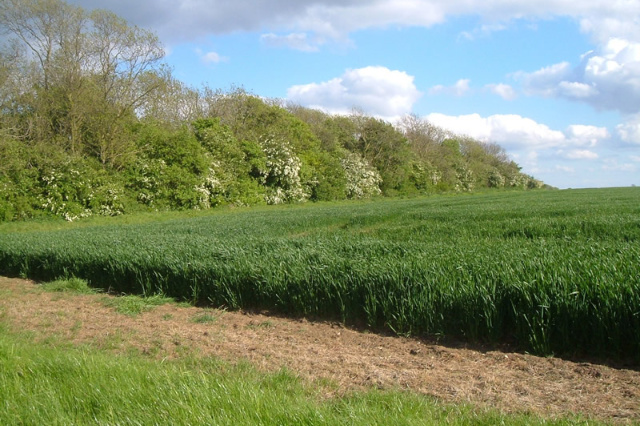
When the grass is about 50cm tall we cut it down with the mower on the back of the tractor.
After the grass has been cut it needs to be dried out, this is done using a hay turner, it is a machine that goes on the back of the tractor that has two rotors covered in spikes that spin round spinning the grass everywhere. The amount you turn the grass depends if you are making hay or silage, silage only needs doing a couple of days, but hay needs doing every day for about 7 to 10 days
When the silage or hay is ready we then go with the tractor and baler to collect it all into bales.
The baler has a rotor on the front that picks up the grass then wraps it round and round until there is enough grass in the baler to make a bale. The baler then ties the bale with something called net wrap to hold it together then the back door opens and the finished bale drops out.
For silage the bales need to be wrapped in black plastic to preserve the grass, it’s similar to putting food in your freezer at home to preserve it. We use a machine called a bale wrapper for putting the black plastic on the bales, the bale wrapper fits on the back of the tractor, you drive up to the bale then a grab picks up the bale and places it on to the turntable, the turntable then starts spinning and wrapping the bale in plastic wrap, once all the bale is covered in wrap the bale then gets tipped off the back of the wrapper.
After all the bales in the field have been wrapped we then transport them back to the farmyard and stack them for storing ready for use in winter.
One of the best but most tiring parts of spring is lambing time, its brilliant to see all the newborn lambs but sheep are good at giving birth at the 3 in the morning which means you have also got to be there at 3 in the morning just in case they need help in lambing.
After lambing, the sheep will stay in the barn with her lambs for 2 or 3 days until the lambs have had time to bond with their mother so that when they go out into the field with the other sheep and lambs they will know who their mums are. We also paint a number on all the sheep and lambs using a special animal marking paint so that we know which lambs belong to which sheep.
When the weather starts to get warmer the crops begin to start growing, but for them to start growing they need some help, we apply fertiliser which is a mixture of nitrogen and sulphur to encourage them to grow, its similar to us eating food, they also need food to allow them to stay alive and grow.
To put the fertiliser on the crops we either use a crop sprayer or a fertiliser spreader like in the above pictures. The fertiliser spreader has a big hopper that holds the fertiliser then it gets dropped onto 2 spinning discs below the hopper that spread the fertiliser 24 metres wide. The fertiliser in the hopper looks very similar to salt that you might put on your food.
We have to spray the crops to keep them healthy from infections, It’s very similar to us taking medicine to keep us healthy when we get poorly. We also spray the crops with special nutrients, again similar to us taking a multivitamin.
The machine used to put the spray on the crops is called a sprayer, it has a big tank to hold the spray in and then when in the field it sprays it out 24 metres wide using lots of jets like on a water pistol spread across 2 booms which look like wings on an aeroplane.
Before the cattle go out into the fields we roll them to repair any damage where the cattle may have trampled the grass the previous year, it also levels out any molehills and encourages the grass to grow.
Summer
Summers here and it’s the farms busiest time of the year, the crops have turned golden and are ready for harvest.
To harvest the crops we use a machine called a combine harvester, the combine harvester cuts the crop with the header on the front, the crop then gets fed inside the combine harvester where it goes through a rotating drum that beats all the grain out of the ear, the ear is the part of the plant where the grain is produced. After the grain has been separated it gets taken into the hopper at the top of the combine harvester. When the hopper is full of grain an unloading auger folds out from the side of the combine harvester and sticks out over the top of a trailer that is waiting to take the grain back to the grain store. The rest of the plant carries on through the combine until it falls out the back into rows ready for baling.
A baler is a machine that collects all the straw and makes it into bales. To make the bale the tractor and baler drive along the rows of straw and as it drives along with a rotor with about 100 metal tines on spins around picking up all the straw and feeding it into the baler, once in the baler the straw gets compressed by a big metal arm and is pushed into a square shape. The baler keeps picking up the straw and compressing it until there is enough straw to make a bale 240cm long, 120cm tall, 100cm wide and weighing about 550kilograms (approx half a tonne) this is about half the weight of a small car. When the bale is big enough it then ties 6 lengths of string around it to hold it together before dropping the bale out of the back of the baler.
When the baler has got all the straw made into bales we then laden them onto a trailer with the forklift and transport them back to the farmyard.
Back in the farmyard we then unload the bales off the trailer with the forklift and stack them in the barn to keep them dry. It is very important that the bales are kept dry as they are like big sponges that soak up the water when it rains which then rots the bale making it no use for feeding animals with, its similar to our food going mouldy as we wouldn’t want to eat mouldy food. The bales are stacked right up to the roof which is about 7 metres high to get as many bales in the barn as possible.
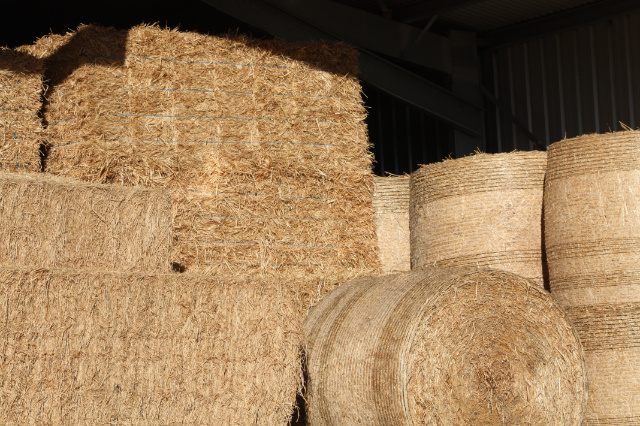
Autumn
When all the fields have been harvested and baled the first job is to go over the fields with a stubble rake, the stubble rake scratches the top 5mm of soil making it ideal for weeds to grow, the idea of getting the weeds to grow is so we can then kill them with weed killer so that we get fewer weeds growing in the crops after they have been planted. The weed killer is basically the same as the weed killer you can get from garden centres to kill weeds in your garden.
To apply the weed killer we use the crop sprayer which sprays the weed killer on the ground through 72 jets that are fastened along the booms which look a bit like wings on an aeroplane. The big tank on the sprayer holds 2200 litres of weed killer which is enough to cover 35 acres, about the size of 20 football pitches.
Remember back in winter when we mucked out the cattle pens and took it and put it in a heap in the fields, well now the fields are harvested we spread the muck on the fields using a muck spreader. To get the muck from the heap to the muck spreader we use the forklift with a grab on the front that scoops up the muck and then tips it into the muck spreader. The muck spreader is like a trailer with two vertical rotors at the back and a rolling floor, the rolling floor is like a treadmill at the gym, when it goes round it carries the muck along to the back where the two spinning rotors spin the muck out and spread it about 12 metres wide.
The muck is very good for the fields as it is full of nutrients that help make the crops grow.
Next thing is to cultivate the fields, cultivating is where we rip up the stubble left from the previous crop and loosen all the soil so that we can plant the next crop in the field. The farm has many different types of cultivators that all do different jobs. There are two main types of cultivation, either ploughing or min till, ploughing is when you use a plough to turn over the top 15cm of soil and min till is using a cultivator that has tines that rip into the soil followed by rotating discs that chop into the soil that only cultivates the top 5 to 10cm of soil. On the farm we use both of these methods of cultivation depending on what crop we want to plant in the field and also the weather conditions.
Whether we are going to plough or min till the fields we firstly use a sub soiler, this machine gets towed behind the tractor and has 5 long tines that go between 25 and 35cm deep into the soil, the tines pull through the soil loosening the soil after them. The reason we like the soil loose is so the next crop can grow easily in it and the plant’s roots can go down into the soil, another reason is that when it rains the rainwater can drain quickly through the soil helping the prevention of the field flooding.
This is one of the cultivators that we might use if we are going to min till the fields, above I was explaining about the tines and rotating discs that min till cultivators have. The tines are the long metal rods just behind the tractors rear wheels, these pull through the soil about 10cm deep. The rotating discs are just behind the tines, these chop through the soil at a depth of about 5cm and also cut up any big lumps of soil that the tines may bring up.
The size of a plough is measured by how many furrows it has, the plough we use on the farm has five furrows, it has five furrows sticking up above the plough and also five below the plough. A furrow is the part of the plough that rips through the soil, the furrow has a metal point at the front that rips into the ground followed by a curved piece of metal that pushes the soil to the side then turns the soil upside down. Ploughs usually have two sets of furrows, one set on top and another set below, this is because the plough pulls through the ground diagonally, so when going across the field with the land you have already ploughed on the left-hand side of the tractor the plough needs to be pointing diagonally to the right, but when you go back across the field the other way and the land you have already ploughed is now on the right-hand side of the tractor you have to turn the plough upside down by pulling a lever in the tractor so that the plough points diagonally to the left.
After the land has been cultivated it needs breaking down, this means smashing up all the big lumps of soil left by the cultivator. To do this we use a cultivator called a press, the press has some tines at the front that level the soil followed by two sets of rollers that squash the lumps of soil breaking them down to the size of tennis balls or less.
While cultivating the land the soil gets ripped open exposing the worms that live in it. All birds, especially seagulls like eating the worms, there can often be hundreds or even thousands of seagulls following behind you trying to find the worms.
The final stage before planting the next crop is making a fine seedbed. This means breaking down the lumps of soil even more, we like the soil to be really fine with no lumps to give the next crop the best chance of growing.
To make a fine seedbed we normally use a cultivator called a SKH crumbler, it has a set of tines to level the soil followed by a roller, this is then followed by another set of levelling tines and another roller but this roller goes round twice as fast as the front roller, the rollers hit the lumps of soil and smashes them to pieces.
The planting machine is called a seed drill, the seed drill plants the seeds into the ground. The seed goes in the big red hopper at the top of the seed drill, the seed then goes through a metering device that measures out the seeds so that only so many seeds get planted per acre. After the metering device, the seed travels along tubes which are a bit like a hosepipe, at the end of the tube there are coulters, the coulters are metal tines that pull through the soil, the seeds drop out behind the coulters into the soil. The soil is then levelled out by a set of rakes at the back of the seed drill.
The final stage after planting the new crop is rolling the soil, the rolls break any lumps of soil the seed drill may have made and it also squashes the soil tight around the seeds so that they grow better.
